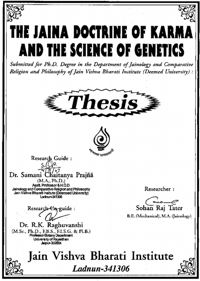It is suggestive from the study of rise of karma etc. from the points of view of dravya (substance), kṣetra (locus), kāla (time), bhava (life of birth), and bhāva (condition) [95] that both physical and mental traits are the result of the interplay of both genetic (from the aspect of dravya) and environmental factors (i.e. from the aspects of kṣetra, kāla, bhava and bhāva).
According to Biology "a few genes, such as those that determine the blood groups, produce their effect regardless of environment. The expression of other genes may be markedly affected by altered environment.[96] The upper limit of person's mental ability is determined genetically as it indicates in the later stages (dasas)[97] of its life but how fully he develops inherited abilities is determined by environmental interferences by his training and experience.[98] It is easy to understand why the offspring of intelligent parents are sometimes less intelligent (manda) than either parent because of past karma.[99] Biology explains that since the co-ordinate of many pairs of genes is involved in intelligence the fortunitous combination of these which produced the intelligent parents be broken by genic segregation. Conversely, the chance recombination of favourable genes may produce a brilliant child from average parents, but genius are never produced by feeble minded parents).[100]
The inherited gene complex or genetical mould of an organism is called genotype. It is determined by the number type and a management of genes in the originating festilized egg or seed. The trait actually contributed by the offspring or its outward appearance is called phenotype. The phenotype includes all obseverable traits whether anatomical, physiological, psychological, mental or whatever. The phenotype of an organism is, therefore, the consequences of the growth - and development of a genotype in a certain environment.
In short, the fertilized egg develops into a new organism because of the action of genes and chromosomes it inherits from its parents on the ambient environment.
Every organism has its own characteristic form of metabolism whereby it responds during the course of its development to the components of its external environment such as food, nutrients, water, air, heat, light etc. in its own peculiar way. Although metabolic patterns are different in different organisms, the goal of every metabolism is essentially the same, namely, to enable the organisms to assimilate the materials in its environment to become a more or less faithful copy of its parents and other ancestors. That it becomes a faithful copy is due safely to the genes and chromosomes it inherits in the originating bit of parental body. But the qualifying "more or less" is a consequence of the environment in which the initial 'bit' grows. Thus while the genes inherited in the parental bit ensure the recurrence of the forms of metabolism in the progeny, the lambient environment in which the bit grows determines the way the inherited metabolism actually manifests itself.
This is why both heredity and environment go hand in hand in shaping the life of the offspring from cradle to grave.
It is therefore obvious that consideration of life without its environmental support is all but meaningless. All life is the out come of a complicated interaction between heredity and environment. However, even though both the heredity and environment determine the characteristics of the offsprings, different characteristics in the offsprings do differ widely in the degree to which they are dependent on hereditary genes and the prevailing environment. At one extreme there are traits which wholly depend on the genes the organism carries regardless of the environment so long as it is at all compatible with survival and growth. A case in point is varieties of peas which may either be wrinkled or round, whether a pea which wrinkled or round is purely a gene effect. Likewise, whether a man will be blood group A or B, whether a cow will be horned or hornless and whether a mouse will be gray or white, depends wholly on genes it carries no matter what the environment is. On the other hand, there are cases where even individuals having identical genes may develop different qualities in different environments.[101]
 Prof. Dr. Sohan Raj Tater
Prof. Dr. Sohan Raj Tater
 Doctoral Thesis, JVBU
Doctoral Thesis, JVBU